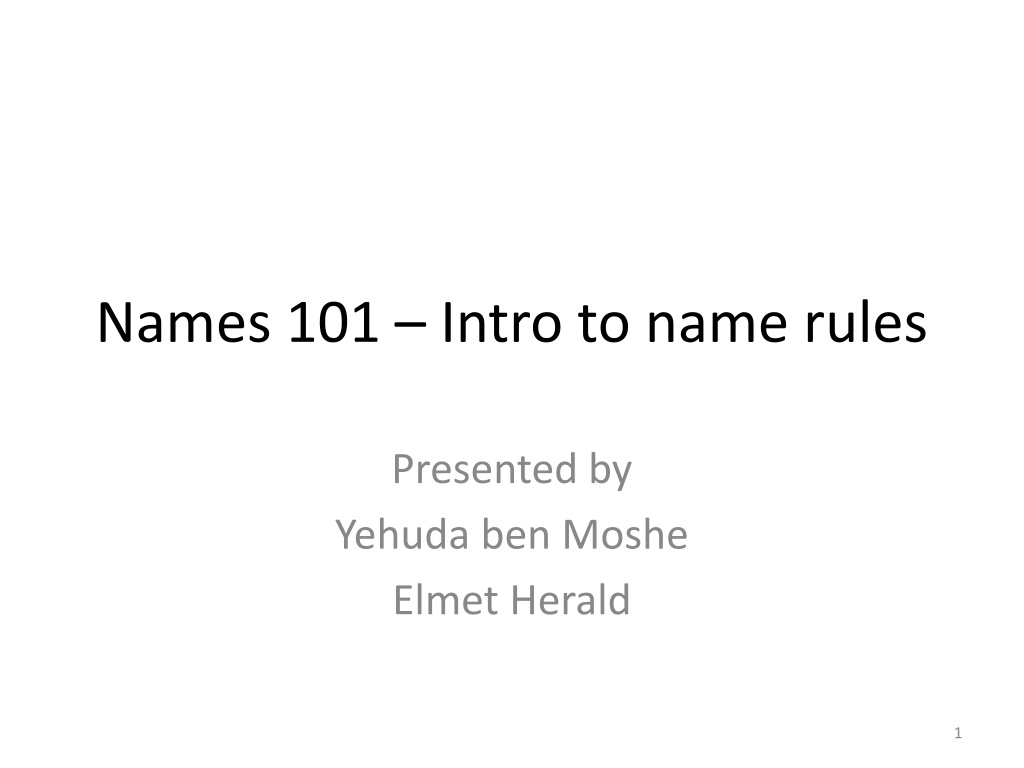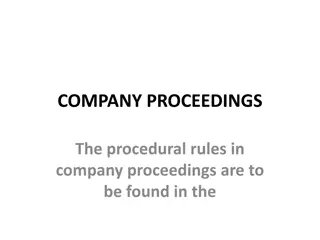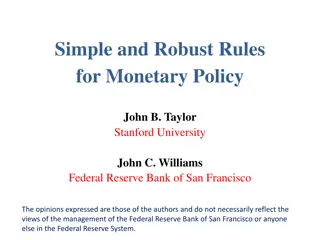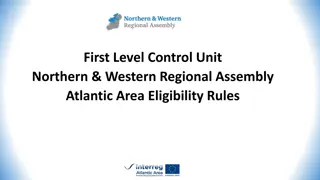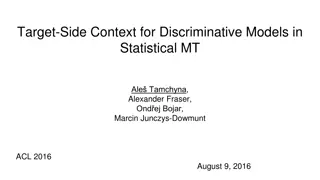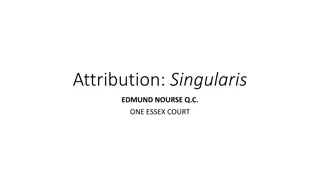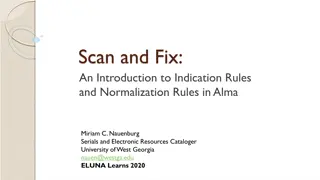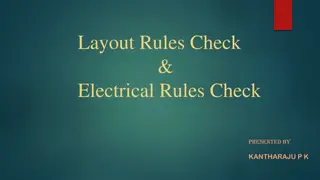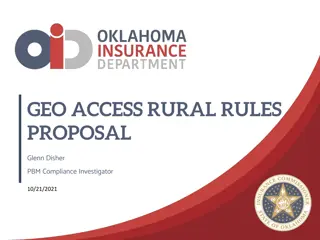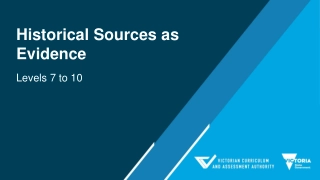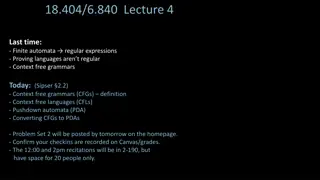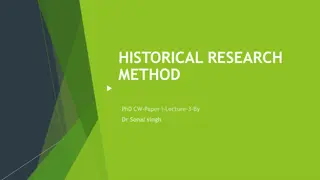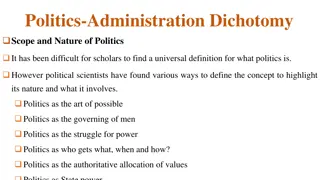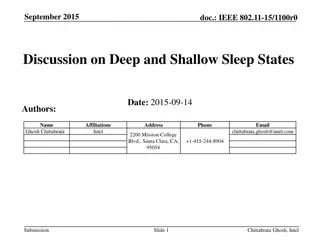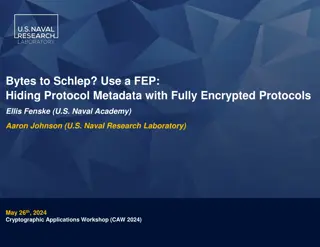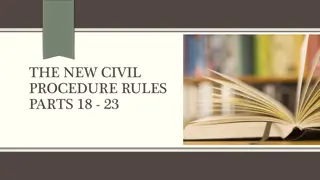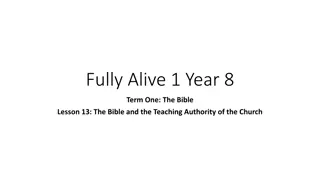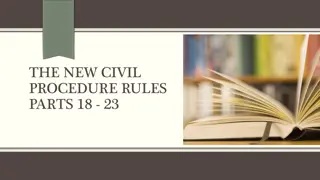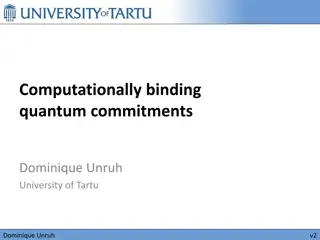Understanding Name Rules and Definitions in Historical Context
Exploring the intricate rules governing names in historical contexts, this presentation delves into various types of names such as personal, non-personal, heraldic titles, and more. It also delves into the period definitions, different types of bynames, and their cultural significance.
Download Presentation

Please find below an Image/Link to download the presentation.
The content on the website is provided AS IS for your information and personal use only. It may not be sold, licensed, or shared on other websites without obtaining consent from the author. Download presentation by click this link. If you encounter any issues during the download, it is possible that the publisher has removed the file from their server.
E N D
Presentation Transcript
Names 101 Intro to name rules Presented by Yehuda ben Moshe Elmet Herald 1
Introduction Types of names Personal (PN) Non-Personal (NPN) SCA Branches Heraldic Titles Award Orders Households Non-personal names not covered in this class, but many things in common 2
Period GP3A: Definition of Period - Time Generally before 1600 The period 1600-1650 is known as the grey period Elements will usually be allowed No official beginning time, but must be from cultures known to Medieval and Renaissance Europe Classical Greek and Roman elements are acceptable Elements from Pharaonic Egypt are not acceptable 3
Period GP3B: Definition of Period Place Any part of Europe is always allowed Names from other cultures that had contact with period Europe are allowed for people and households Not allowed for SCA Branches 4
Definitions Given Name Main personal name Usually given at birth or naming ceremony The modern First Name is a given name Some cultures allow multiple given names Such as modern middle name 5
Definitions Byname Part of the name other than a given name Different cultures had different types of bynames Not all cultures had all types of bynames Modern last name is a type of byname, specifically an inherited surname Different types of bynames described in detail in SENA Appendix B 6
Definitions Types of Bynames Locative Describes where the person if from Can be marked of York de Marseilles von Hamburg Can be unmarked Jack London 7
Definitions Types of Bynames Patronymic Formed from the person s father s name Some of the earliest and most common bynames Can be marked Nialsdottir Johnsson Petrovich Can be unmarked John Henry Occasionally, matronymics (mother s name) were used 8
Definitions Types of Bynames Descriptive Formed from a distinguishing characteristic the Tall Grosse gullskeggr 9
Definitions Types of Bynames Occupational (type of Descriptive bynames) Describes the person s occupation Draper Guerrero Sardello 10
Definitions Types of Bynames Congnomento, alias, or dictus A second given name the person goes by Iohannes dictus John Inherited Clan names Conchobhair (masculine) inghean U Chonchobhair (feminine) Inherited surname Basically the modern last name 11
Definitions Name Phrase A complete given name or byname, including all associated prepositions, articles, and requirements Naming Pool A group of name phrases that are in use in a particular place and time Regional Naming Group A group of naming pools that are culturally linked 12
Rules To be registerable, the following must be met: Each name phrase must be acceptable (PN1) The combination of name phrases must be acceptable (PN2) The name must be free of: conflict (PN3) presumption (PN4) offense (PN5) 13
Rules Name Phrases Single Place and Time (PN1B1) A Name Phrase must be internally consistent as to grammar and structure for a single time and place A Name Phrase may not mix languages unless such a mix is attested Example von Saxony No von Sachsen Ok of Saxony - Ok 14
Rules Name Phrases Sources of Name Phrases Attested (PN1B2a) A name phrase is considered attested if the complete name phrase is found in an acceptable source Minor spelling variants that are demonstrated to be compatible with the spelling conventions of the name and place are allowed In Renaissance English, i and y were interchangeable, so the attested name Annis can also be spelled Annys A single period example of an attested name phrase is enough for registration 15
Rules Name Phrases Sources of Name Phrases Constructed (PN1B2b) A name phrase can be constructed using a period pattern of name construction Three documented examples of the desired pattern are generally required for registration Dimunitives In some languages created by adding or removing an ending For example, in Italian, Urbanino can be constructed from Urbano 16
Rules Name Phrases Sources of Name Phrases Constructed (PN1B2b) Dithemic (two-part) names can be constructed from one prototheme and one deuterotheme Can t use any other combinations Example The attested Old English lfgar has the prototheme lf- and the deuterotheme -gar The attested Old English Eadmund has the prototheme Ead- and the deuterotheme -mund Therefore lfmund is a valid constructed name Garmund , lfead , and lfgarmund are not 17
Rules Name Phrases Sources of Name Phrases Constructed (PN1B2b) Bynames constructed from given name elements For names such as patronymics Example In Old Norse, standard patronymic for men consists of the possessive form of the father s name plus the word son From the attested given name Bjartmarr one can created the patronymic byname Bjartmarsson 18
Rules Name Phrases Sources of Name Phrases Constructed (PN1B2b) New place names can be constructed from attested elements Example Oxford , Swinford and Hartford are attested English place names The pattern is large hooved animal + -ford This would allow the construction of Sheepford This would not allow Bookford or Duckford 19
Rules Name Phrases Sources of Name Phrases Lingua Anglica Allowance(PN1B2c) Allows translation of name phrase into standard modern English Applies to attested or constructed descriptive, occupational, and locative bynames Preserves the meaning for the benefit of modern speakers 20
Rules Name Phrases Sources of Name Phrases Lingua Anglica Allowance(PN1B2c) Must be a literal and plausible translation The Norse inn rau i can be translated as the Red Cannot be translated as the bloody , the scarlet , etc. 21
Rules Name Phrases Sources of Name Phrases Lingua Anglica Allowance(PN1B2c) For locatives, must be the standard modern English version of the name While Cairo is derived from the victorious , the lingua Anglica form is of Cairo , not of The Victorious al-Qahira is the Egyptian spelling, but of al-Qahira is not allowed as lingua Anglica, since the standard English form is of Cairo This rule may not be used to translate the meanings of given names or place names 22
Rules Name Phrases Sources of Name Phrases Borrowed Names (PN1B2d) Name phrases may be borrowed from Secular literature The Bible Other Religious Literature Names of Saints Must be linguistically appropriate For example, the Arthurian character Lancelot is found in Italian as Lancilotto , therefore, Lancilotto is the form allowed in an Italian context 23
Rules Name Phrases Sources of Name Phrases Borrowed Names (PN1B2d) Must fit within a pattern of borrowing names Evidence of borrowing given names does not support borrowing bynames Evidence of borrowing names of major characters doesn t support borrowing names of minor characters Evidence of borrowing from one type of literature doesn t support borrowing from another type 24
Rules Name Phrases Sources of Name Phrases Legal Name Allowance (PN1B2e) An element from the submitter s legal name may be used Must provide proof of the name Must be exact same form and spelling as in legal name Must be used in the same manner Given name as given name Surname as surname Middle names vary Must meet all other rules May not be obtrusively modern 25
Rules Name Phrases Sources of Name Phrases Branch Name Allowance (PN1B2f) Can always use of Branchname as a byname Must use exact spelling, grammar, and language as in registered SCA branch name of the East Ok von Osten No Can only use the Lingua Anglica of of Fontaine dans Sable Ok de Fontaine dans Sable - No Households are not branches 26
Rules Name Phrases Sources of Name Phrases Grandfather Clause (PN1B2g) Name phrases previously registered to an individual may be registered again, even if not currently registerable May not allow one to evade new problems, only existing ones Can also be used by close legal relative, with proof or attestation of the relationship 27
Rules Name Phrases Finding Attested Name Phrases Articles on heraldry.sca.org and s-gabriels.org Books of period names Dated forms Spelling not normalized Period documents FamilySearch 28
Rules Construction All registerable personal names must contain a given name and at least one byname (PN2B) Single given names, though period, aren t registerable Each name phrase must be grammatically correct for its position in the name Fearchar is a Gaelic given name Becomes mac Fearchair (m) or mhic Fhearchair (f) 29
Rules Construction Culturally uniform names (PN2C1) A name which matches a pattern of the grammar of names for a single time and place For example: 14C England Must use an overall pattern documented to that time and place See Appendix A All name phrases must be from the time and place to be considered uniform names 30
Rules Construction Appendix A 31
Rules Construction Culturally mixed names (PN2C2) If all name phrases are from the same regional naming group (See Appendix C), they must be dated within 500 years of one other If the name phrases are from two regional naming groups listed as compatible in Appendix C, they must be dated within 300 years of one another 32
Rules Construction Appendix C 33
Rules Construction Culturally mixed names (PN2C2) For non-Appendix C combinations, must document If all name phrases are from naming pools which can be documented as being used together in personal names of real people, they must be dated within 300 years of one another At least three period examples must be provided of a names combining the phrase pools 34
Rules Construction Culturally mixed names (PN2C2) If a name phrase is documented under the legal name allowance, branch name allowance, or grandfather clause, it s treated as neutral in language and time May be combined with name phrases from a single regional naming group dated within 500 years of one another May not be combined with name phrases from two or more regional naming groups 35
Rules Construction Names In Non-Latin Scripts (PN2D) Only names in a Latin script are registerable Names originally in other scripts must be transliterated Russian, Japanese, Arabic, Norse runes, etc. Must be transcribed using any standard transliteration system Many are listed in Appendix D 36
Rules Construction Names In Non-Latin Scripts (PN2D) Must use a single system for all name elements Example In Arabic, Amina al-Hamadaniyya or Aminah al- Hamadaniyyah Ok Aminah al-Hamadaniyya No Either use all the funny characters and accents, or none In Gaelic, Tom s M r or Tomas Mor Ok Tom s Mor or Tomas M r - No 37
Rules Obtrusive Modernity Names that are obtrusively modern are not permitted (PN2E) Joke names are acceptable Drew Steele , Mould de Cheder , Hillarius Drunk Names that yank the reader out of a medieval mindset and into a modern or fantasy mindset are not Porsche Audi , Artemisian Tank Corps , Gecky (pronounced geeky ) Herald 38
Rules Names must be free of conflict, presumption, or offense Conflict prohibits names that are too close to another SCA name (PN3) Permission can be given to resolve a conflict Presumption prohibits names that are too close to an important non-SCA person, or which claim special powers or position (PN4) Permission cannot resolve a presumption problem Offense prohibits names that are offensive to the populace or general public (PN5) 39
Rules Presumption Presumption is the impermissible claim to rank, power, identity, or relationship with a non-SCA person (PN4) Letters of permission cannot allow the registration of a presumptuous name Many different types of presumption 40
Rules Presumption Claim to Rank Use of an element that appears to be a title (PN4B1) Attested bynames identical to SCA titles may not be used unless the submitter is entitled to the title Only KSCA may register the byname Knight or Chevalier However, as Italian for Viscount is Visconte , the byname Visconti is permitted, even though derived from the same root 41
Rules Presumption Claim to Rank Use of an element that appears to be a title (PN4B1) Bynames identical to non-SCA titles are not considered presumptuous if persons not holding that rank used such bynames Pope is a surname used by normal people, and therefore can be registered Attested given names identical to titles can only be used if obviously not a claim to rank Regina of England is presumptuous Regina the Laundress is not 42
Rules Presumption Claim to Rank Use of an element that appears to be a title (PN4B1) Attested bynames incorporating the names of Society orders or real-world orders are not presumptuous de la Rose or atte Pelican are not presumptuous Those entitled to a permanent SCA rank may use the rank in the name Court barons may use Baron as a byname, landed barons may not No one can use King or Princess 43
Rules Presumption Claim to Rank Dynastic Names (PN4B2) Bynames used uniquely by a single dynasty may not be registered Hohenstaufen was used by a single ruling dynasty and is unregisterable Bynames used both by a ruling dynasty and by normal people are permitted Tudor , Stuart , Bourbon 44
Rules Presumption Claim to Rank Combination of Family Name and Location (PN4B3) Names combining the byname of an important noble family and the area that family rules are not permitted Campbell of Argyll Tudor of England These bynames and locatives may be ok by themselves 45
Rules Presumption Claim to Rank Honorific Names (PN4B4) Name phrases only given out as awards may not be used Salah al-Din , Saif al-Mulk Combination of Occupational and Locative (PN4B5) Combinations that suggest an official position are not allowed Bard of Armagh or Champion of Ealdormere No Laundress of York - Ok 46
Rules Presumption Claim of Powers (PN4C) Names may not contain unmistakable claims of superhuman abilities, magical powers, or divine origin Names that were used in contexts that make it clear to not be a claim of power are permitted Odinson is permitted, since normal humans used it as a byname Lokasson is a claim to divine origin, as the only known use of Loki is of the Norse god 47
Rules Presumption Important Non-SCA People (PN4D) Names may not make claim identity or close relationship with important non-SCA people Same rules as for conflict Names of important people are protected in all forms in which their names were known Christopher Columbus , Cristobal Colon , Christophors Columbus are all protected While Carlos V of Spain was also the count of Barcelona, we do not protect Carlos of Barcelona as his name was not recorded in that form 48
Rules Presumption Important Non-SCA People (PN4D) People who are not important enough to have an entry in a standard print encyclopedia are generally not important enough to protect Sovereign rulers of significant states are generally considered important Individuals whose names are recognized by a significant number of people in the SCA are important enough to protect 49
Rules Presumption Important Non-SCA People (PN4D) Fictional characters if A significant number of people in the SCA would recognize the name, and The use of the name would be considered a reference to that character Combination of a name and device may be presumptuous, even if each one is allowed by itself York and a white rose; Lancaster and a red rose 50
